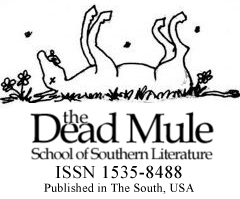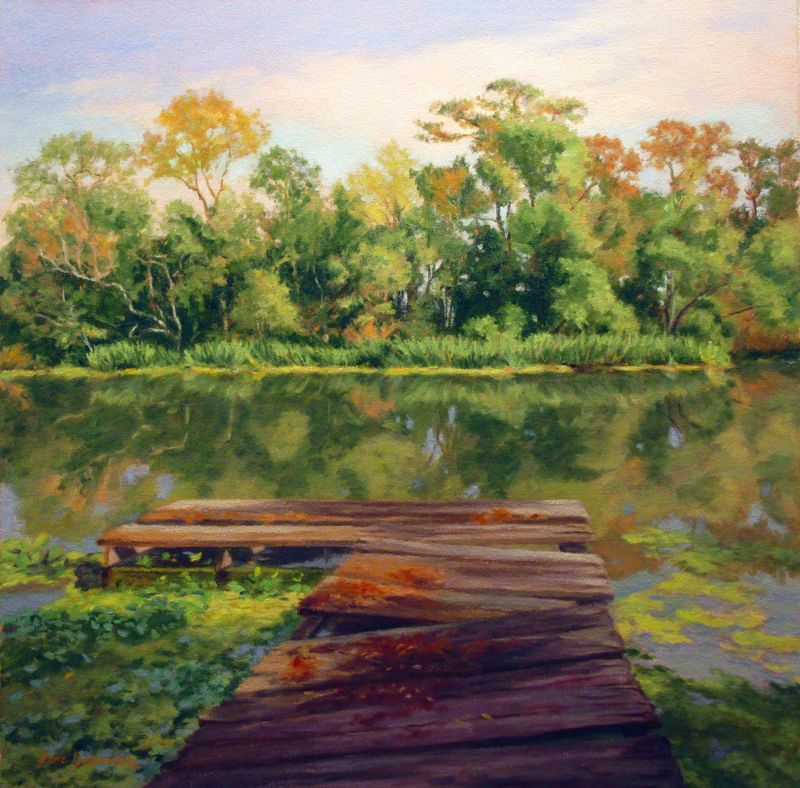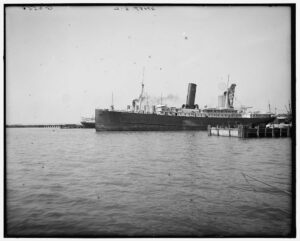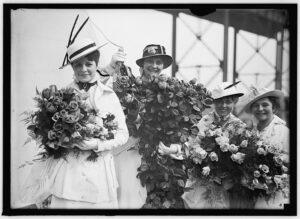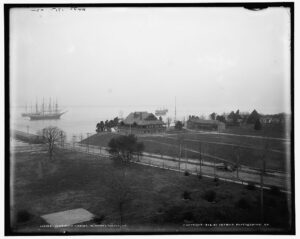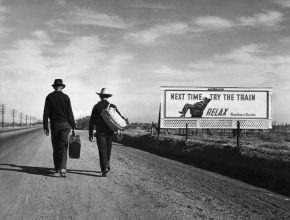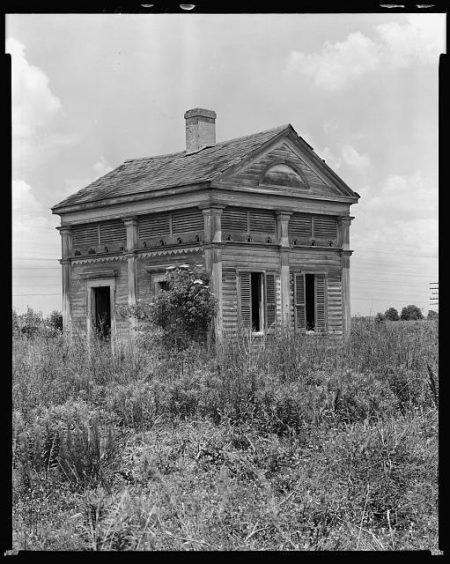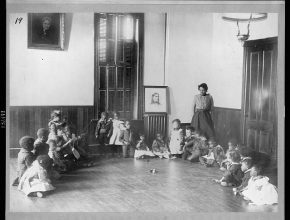Southern legitimacy statement: As I tell my students, I am from as far South as you can get: Franklin, Louisiana is at the bottom of the state. I grew up on the Bayou Teche there, in a plantation house my parents restored. I now call eastern North Carolina home, where I live part-time on the Pamlico River. I teach at East Carolina University where I am the Rives Chair of Southern Literature and have served as Editor of the North Carolina Literary Review for over 25 years. I’ve written about Southern writers through most of my career, but have turned the page and am writing a memoir these days.
art by Jane C. Desonier https://www.janedesonier.com
Ted’s Push
“They set you up for life with more than a happy name. They gave you a happy childhood. You had all the security you needed for those first ten years before your world flew apart. If a person has a secure childhood to build on, he’s indestructible. That’s my theory. I don’t mean he’ll never get sick or have a traffic accident, but his inner core will be indestructible, whatever happens afterwards.”—Gail Godwin, Southern Family
Outside the Franklin, Louisiana “city” limits, circa 1975
Ted’s “push” (as he called it, and thereafter it became) was the reel cart for coiling up a water hose and then rolling it from spigot to spigot when you have a yard big enough that such equipment makes watering easier. I don’t remember ever seeing a hose wrapped around this contraption. Likely, what must have seemed like a good idea turned out to be more trouble than buying multiple hoses and leaving them each coiled at a different spigot for easy reach when needed.
What I do remember is my baby brother calling the red hose-reel cart his “push” and as Ted, a toddler then, pushedit around the yard pretending it was a lawn mower, Daddy remarking, “Hundreds of dollars’ worth of toys in his room, and Ted’s favorite toy is his push.”
An old black man named Willie Bell mowed most of the lawn of our seven-plus acres from atop a big yellow tractor, a precursor to today’s riding lawnmowers. He used a regular push mower in places the tractor had difficulty accessing, like the grassy area between Mom’s rose garden and the driveway. And Ted would pull out his push whenever he was in the yard to “work” with Willie. Then, puh-puh-puttering his motor mouth, he would follow Willie around, “mowing” with his push as Willie mowed, trimmed hedges, or edged walkways.
While Ted pretended to mow the lawn beside Willie, my sisters and I were likely imagining explorations that took us through the ditch that ran alongside a long, thick row of Viburnum shrubbery just inside the western property line of our yard. We could entertain ourselves for hours by starting at the back, northwest corner of the yard, behind the barn, and “hacking” our way through the bushes to the front corner—the length of about a football field and a half—pretending (with long sticks or toy swords) we were cutting our path through a jungle.
At about the halfway point of our wilderness trek, we’d find the small, cracked gravestone, most of it on the ditch bottom, the piece broken off leaning against the side of the ditch. Major Civil War battles had been fought on the Bayou Teche, which ran along our back yard, but according to Dad, the marker, etched with only a single first name (that I no longer recall), was likely for someone’s beloved dog. We rejected such a mundane possibility and did not share that notion with our friends, who believed us when we told them a Confederate soldier was buried below (oldest sister Carla having read about Confederates in her Little Colonel books).
After paying our respects to the unknown soldier, we resumed our venture, the bushes we pushed through growing thicker as we proceeded. We knew we were coming to the end of our jungle safari when the sound of cars and eighteen-wheelers penetrated our wilderness imaginings. Highway 90 lay on the other side of the white wrought-iron fence that ran along our front yard. Reaching the bars of the west end of that fence, we would emerge from the bushes onto the lawn, halted from further progress forward by the traffic as much as the fence. At that time, the two-lane old Highway 90 was the major East/West throughway from town to town in south Louisiana. The contrast between it and every other street in town was significant. Travelers were still driving at a highway speed where we were, just outside of the city limits.
Undaunted by the barriers to our forward progression, we would emerge from the bushes, turn back, and perhaps race each other to the bayou, now running alongside the “jungle.”
Approaching the wharf at the other end of our property, we did not stop. We leapt over the gap at the bayou bank where a few planks were missing, often hearing a splash behind us as we landed on the pier. We’d turn and catch a glimpse of a water moccasin slipping into the water. Realizing it had been sunning in the mud underneath the space just hurdled would make a heart skip a beat or two. Moccasins are common in south Louisiana, but we knew no child who’d actually been struck. As we played along the bayou behind our house, we often scared ourselves by speculating aloud that a stirring in the brush and water lilies growing along the bank was a snake, but in all those years, none of us ever had a closer encounter with a moccasin than those after-the-leap glimpses at the base of the beat-up wharf.
Also on the west side of these seven acres between the bayou along the back and the iron fence along the front yard sat the playhouse Uncle Hugh brought over when his daughters aged beyond make-believe housekeeping. The new (to us) structure was about three times as wide as our old outhouse-sized playhouse that still sat next to the dog pen behind the garage. That one was just an empty square of space with a single window on the back wall, a tiny shelf underneath it, a screen door in front. Quite a contrast to the playhouse Uncle Hugh, a contractor by trade, had built for his daughters, which had two stone steps leading up to a tiny porch, two windows in front, one on each side of the wooden door into the house. Both sides of the little house also had windows. A tiny mock fireplace (no flue, no chimney) faced the front door entrance from the back wall. Over twice the size of the older playhouse, the hand-me-down one was placed farther away from the house, toward the bushes we liked to explore, amongst the large oaks, pecans, and magnolias, where we could recreate scenes from A Little House in the Big Woods and other volumes of my beloved Little Houseseries of books by Laura Ingalls Wilder.
We set up a living and sleeping area on the one side of the rectangle house, a kitchen and eating area on the other. We brought into the “kitchen” the pods of magnolia trees, extracted the red seeds, which became beans in the miniature pots we held over our make-believe fire. We then “battered” the pods by wetting them with water and rolling them in pans of dirt like we had seen Mattie, our housekeeper, batter chicken legs with flour. If the cats wandered by, they became a leopard (the tuxedo), a tiger (the tabby), a cougar (the Siamese), while the dogs played a wolf (the German shepherd) and a bear (the Bouvier de Flanders). Like Laura Ingalls’s family who settled and resettled in various cabins as their father’s restless spirit continued to uproot them, we guarded our own little house against these wild creatures. But we never imagined living anywhere else. Folks from the Deep South typically lack the wanderlust of Pa Ingalls.
Inspired by The Swiss Family Robinson, we also built a treehouse in an oak. Nothing fancy, a couple of plywood platforms at different levels, no walls, some planks nailed into the trunk to make climbing easier. Scraps of wood we found in the barn. We had no parental help. These were days of children playing alone outside once they were school-age, unworried parents going about their various duties inside (Mom) or at work (Dad). Though we usually left Ted in Mattie’s care while we played outdoors to avoid having to watch out for him, he would often wander toward his big sisters’ play, Mattie close behind. I can see her in her white uniform—a dress—standing toward the top of the makeshift ladder while he sat on the lowest, widest platform, within her reach.
I had another favorite climbing tree, a magnolia with low branches to pull up on, then others ascending close together to climb easily and hide within when I was angry with someone. But no one would come looking for me. Once no longer toddler age, children were not watched every minute, our free time not planned out for us. I would not be missed unless I failed to come inside for supper, and usually I got bored in the tree before then. Wishing I’d thought to bring a book with me, I would climb down and head to the house.
A rainy day might also bring our imaginations indoors. We would spend hours setting up a kind of commune for Barbie, Ken, family, and friends. Younger cousin Francie, with her Sandra Dee-style blond hair, not quite as tall or as buxom as your standard Barbie. Completely flat-chested younger sister Skipper with long, straight, platinum blond hair. We would add Buffy (a doll inspired by the Family Affair television show) and our Liddle Kiddles to be children of Barbie and Ken and whichever doll we set up with G.I. Joe. Best friend red-headed Midge, shag-shorn Twiggy, or poor Stacy who fell off my school desk during show-and-tell the same day I got her, my fourth-grade birthday, and was forever after handicapped by a leg that wouldn’t stay on. Even with her long white-blond side ponytail, she was no competition for Barbie. I don’t know why I didn’t think to just swap out her head with one of my older Barbies. They all had the same (perfect) body. Now that I think about it, I can’t remember what my basic Barbie looked like (beyond being blond). I preferred her hangers-on, with their individual personalities.
After we had everyone settled comfortably on wash cloths folded into matching twin beds in most rooms, or not folded, to be the king-sized bed for the matched-up pairs, cotton balls on top for pillows, the extended family all tucked in for sleep, we’d get bored. Sometimes I would quit right about then, go find a book to read, a tree to climb, television to watch.
Other times, we’d pack the Barbie family into Ted’s miniature Winnebago, put his G.I. Joe in the driver’s seat, and send them all plummeting down the grand staircase of our antebellum home, a waterfall in our imaginations.
Then we would follow them down, grab a snack in the kitchen while they abandoned their vehicle and swam to shore in the great hall, with its three 1970s-green rugs, an avocado and chartreuse mix, two rectangles on either side of the round one at the foot of the stairs. Island adventures for our bored Barbies.
And when that story played out, the den was just off the hall, and Star Trek or Lost in Space reruns would inspire us back upstairs to put on the tights and leotards we pretended were our space uniforms, then outside to explore the planet we’d just landed on.
“Go outside and play,” my mother would say, sometimes a suggestion, other times an order. But even if intended as a punishment for some indoor infraction, outdoors provided numerous options, and we were usually worn out upon coming inside for supper, baths, and bed.
Surprisingly, I don’t remember the south Louisiana heat and humidity being overwhelming as we slipped into the imaginary worlds we created following one of us saying, “Let’s pretend . . . ”
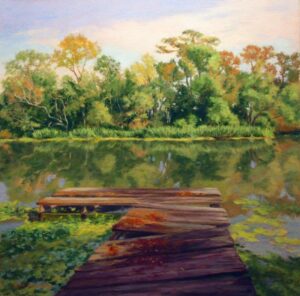
###
